Institutionalizing Alliance Skills: Secrets of Repeatable Success
To compete, companies are forming alliances as never before. But quantity does not equal quality. Succeeding in an alliance requires creating the right structures for the right situations.
Why are more companies seeking alliances to remain competitive? On the one hand, financial pressures and time constraints have squeezed managers without the resources to fill the gaps through internal development. On the other, acquisitions have proven expensive and have brought not only the capabilities needed but many that are not desired. Now an increasing number of global enterprises recognize that strategic alliances can provide growth at a fraction of the cost of going it alone. In addition to sharing risks and investment, a well-structured, well-managed approach to alliance formation can support other goals, such as efficiency and productivity. Alliances provide a way for organizations to leverage resources.
As recently as 15 years ago, corporate alliances were few in number and generally limited in scope. Competition was simpler. Most companies did not need to excel in all capabilities in order to compete effectively -- one differential capability was often enough. Companies that lacked a capability either took the time to develop it or bought it through an acquisition.
As the pace of technological change accelerated, however, industry boundaries began to blur. Globalization became the rage. New capabilities were needed to defend current positions and take advantage of opportunities. As competition intensified, strong capabilities were needed across the board, but financial pressures and shortening product-innovation lifecycles left managers without the time or resources to fill the gaps through internal development. Acquisitions were an expensive way to access specific capabilities beyond those traditional to your industry, because you were buying the baby and the bath water -- paying for a lot of unneeded capabilities and often getting involved in managing businesses outside your area of expertise.
The result of these pressures was a surge in alliance activity in all industries and in all types of situations. In the past two years alone, more than 20,000 alliances have been formed worldwide -- and strikingly, more than half of them are between competitors. We are convinced that alliances are a central, essential and permanent engine to achieve growth and profitability. The numbers from our 1997 Survey on Institutionalizing Alliance Capabilities speak for themselves:
1) Strategic alliances have consistently produced a return on investment of nearly 17 percent among the top 2,000 companies in the world for nearly a decade. That is 50 percent more than the average return on investment that the companies produce overall.
2) The 25 companies most active in alliances achieved a 17.2 percent return on equity -- 40 percent more than the average return on equity of the Fortune 500. The 25 companies least active in alliances lagged the Fortune 500, with an average return on equity of only 10.1 percent.
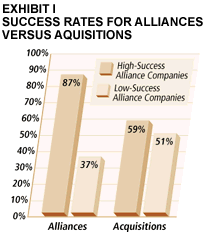 In 15 years of studying corporate alliance activity, we have found that the more experience a company gains in alliances, the greater its returns from them. The lesson seems obvious: companies should move beyond alliance building on an ad hoc basis to creating an institutional alliance capability. When learning is limited to individuals, access to important capabilities is delayed, and sometimes ventures fail. Yet corporate history shows us that institutional learning is not so easily done.
In 15 years of studying corporate alliance activity, we have found that the more experience a company gains in alliances, the greater its returns from them. The lesson seems obvious: companies should move beyond alliance building on an ad hoc basis to creating an institutional alliance capability. When learning is limited to individuals, access to important capabilities is delayed, and sometimes ventures fail. Yet corporate history shows us that institutional learning is not so easily done.
RATIONALE FOR
INSTITUTIONALIZING LEARNING
We all struggle with learning in life. Most of our learning is experience-based, and in most cases we accumulate it as individuals. As adolescents, we did not have much interest in learning from our elders. Now, as managers in corporations, many of us act similarly, continuing to insist on learning from our own mistakes. Our research shows that this has certainly been true for most companies in the alliance arena, where learning by doing has been the traditional way. Practical executives justify this by asserting there is no substitute for learning by doing. Up to a point they are right, but the alliance stakes are becoming too important to be left to the vicissitudes of unschooled management.
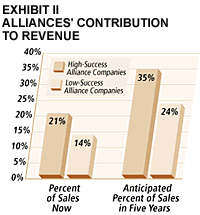 Successful alliance-building companies, for example, average a 90 percent success rate on their alliances, while low-success companies average only 37 percent. This is far better than their results with acquisitions. Both groups of companies did only about 50/50 on acquisitions. (See Exhibit I.) These successful alliance companies also enjoy higher profitability on their alliances -- 20 percent compared with only 11 percent for the less successful companies. This differential is consistent with our earlier surveys.
Successful alliance-building companies, for example, average a 90 percent success rate on their alliances, while low-success companies average only 37 percent. This is far better than their results with acquisitions. Both groups of companies did only about 50/50 on acquisitions. (See Exhibit I.) These successful alliance companies also enjoy higher profitability on their alliances -- 20 percent compared with only 11 percent for the less successful companies. This differential is consistent with our earlier surveys.
Success in alliances also translates into superior growth. The successful companies, on average, see alliances contributing more to current revenues. (See Exhibit II.) More importantly, the alliance capability positions them for faster growth over the next five years. The successful companies expect about 35 percent of their future revenues to come from alliances, up steeply from the current 21 percent and from 15 percent in 1995. Successful companies are also more than twice as likely to be engaged in strategic alliances rather than in the more modest transactional ones. Clearly, it is easy to see the linkage between the strategic nature of these alliances and the higher growth anticipated by the more successful companies.
It is no surprise, then, that C.E.O.'s have come to recognize the value of strategic alliances. Five years ago, our surveys showed that 20 percent of C.E.O.'s in the United States gave a favorable rating to alliances, far lower than the level of acceptance among European and Asian chief executive officers. Today we find that more than 60 percent of C.E.O.'s in the United States approve of alliances, approaching the acceptance rate in Europe and Asia.
Companies in the United States generally lag those in Europe and Asia in alliance skills. This should not be surprising, because Americans are relatively new to this game and are still learning how to form an alliance and make it work. Accordingly, companies in the United States have concentrated more on negotiations, integration and implementation; European and Asian companies more on strategic issues -- managing multiple or global alliances, competing against consortiums and creating alliance organizational structure.
Yet newcomers to the world of multiple alliances find managing the arrangements the most frustrating element. Armed with an understanding of the rewards and motivations for institutionalizing an alliance-capability process, companies will find it easier to plunge ahead.
CHOOSING THE RIGHT
STRUCTURE: SOME "ROADS TO NOWHERE"
Battle-tested alliance executives are often suspicious, and rightly so, of bureaucratic management processes. Some executives maintain that "ad hoc management" and "pure luck" play an important role. Luck certainly helps any alliance succeed. We believe, however, that the "luckiest" and most successful companies are those that learn from others. As Branch Rickey, the baseball executive, once said, "Luck is the residue of design."
In our examination of scores of failed and failing institutional alliance capability approaches, we have identified a number of traps to avoid:
1) Ad Hoc Approach: Rising to the occasion each time
Most companies evolve their alliance approach and capability over time. This ad hoc approach is how most companies in the United States behave today. In this type of company, there is little knowledge capture and few best practices. People are essentially on their own, learning how to do alliances based on their own experiences. In an environment with few alliances, this is adequate. Given the increasing importance of alliances, this approach usually produces frustrating and probably unsatisfactory results.
Most organizations are culturally resistant to change. Starting a strategic alliance process without recognizing this and without an approach to overcoming it is like playing Russian roulette. Most American auto manufacturers chose the ad hoc approach in answering the Japanese assault on the market in the United States. The Ford Motor Company, however, took a step back and marshaled its strengths and resources in a focused manner to negotiate a historic alliance with the Mazda Motor Corporation. Today, Ford and Mazda are so intertwined that it is sometimes difficult to know where one starts and the other finishes. Ford and Mazda are building and institutionalizing an alliance-capability skill base to extend their reach across the globe.
2) Call in the Lone Ranger and Tonto: Relying on deputies
 In these companies, the alliance learning of the corporation resides in one or two specialists who are called in during negotiations to act as the gunslingers of alliance knowledge. This is often quite helpful but has two drawbacks. First, with the surge in the number of alliances, the Lone Ranger and Tonto are quickly overtaxed, even if the Lone Ranger has a small group of deputies. Second, the ranger, given the demands, is usually involved only in the formation of the alliance and not in its management or the institutionalization of alliance skills.
In these companies, the alliance learning of the corporation resides in one or two specialists who are called in during negotiations to act as the gunslingers of alliance knowledge. This is often quite helpful but has two drawbacks. First, with the surge in the number of alliances, the Lone Ranger and Tonto are quickly overtaxed, even if the Lone Ranger has a small group of deputies. Second, the ranger, given the demands, is usually involved only in the formation of the alliance and not in its management or the institutionalization of alliance skills.
That arrangement leaves the operating entities and managers without the guidance and assistance they need. Sometimes "action fever" grows so swiftly that it threatens to sweep away good strategic sense. This problem often stems senior managers' enthusiasm and ad hoc, anti-bureaucratic thinking. But without clear commitment to best-practice development, training, monitoring, rigorous analysis and open communications, many strategic-alliance processes actually breed tension, frustrations and suspicion. This creates unbridgeable gaps. It is not surprising that executives who are hired in the Lone Ranger role become frustrated and often leave the company within five years, taking their knowledge and experience with them. (See Exhibit III.)
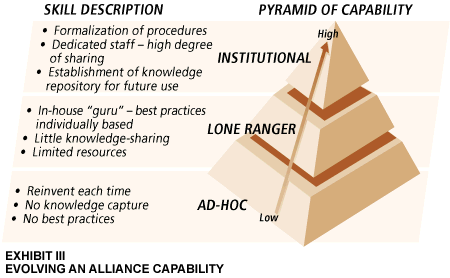
3) Ivory Tower Syndrome: Creating a citadel of alliance thinkers
Some companies view alliance management as an academic art that can only be mastered by specialists steeped in theories, grids and frameworks. We have seen outsiders (consultants) and corporate staff specialists hired to work in splendid isolation, divorced from the realities of the corporate strategic direction and operational requirements. In these situations, the chief alliance executive has very little impact on the strategic nature of alliances and usually plays the role of critical reviewer or sounding board for senior management's alliance ideas.
One of our clients recognized that its strategic-alliance process was exhibiting Ivory Tower Syndrome -- paying more attention to the review process than to increasing business value and filling corporate and strategic-business-unit strategy and capability gaps. Operating managers learned how to submit plans that would satisfy the elaborate alliance review process so they could get on with their businesses. In response to this situation, the chief executive officer restructured the alliance structure. Corporate alliance reviews were shifted from a ritual process to a variable interval reflecting the pace of change in the underlying industry and the significance of the issues confronting alliance formation and management.
4) Not-Invented-Here Complex: Failing to keep an open mind
Failing to learn from others generally produces disastrous consequences. Strategic alliance management and processes often stagnate. Successful alliance companies see alliances as rifles, rather than as automatic weapons. They make periodic and thoughtful assessments of their capabilities and priorities. They use alliances to fill key-capability gaps where acquisitions and in-house development are not appropriate approaches. They also understand their company culture and how it influences behavior, both inside their organization and outside.
Such companies recognize the importance of alliances to their success and reach out for knowledge and expertise to create a well-oiled alliance capability. They know from experience that learning counts -- and counts big. They set up systems and processes to transfer alliance learning and experience to key managers and hold training sessions and workshops. They
also create repositories of knowledge to be tapped into. They know that to manage multiple alliance arrangements takes more than just in-house efforts. It is not surprising to find that the most forward-looking alliance-managing companies -- including Oracle, Xerox, I.B.M., Hewlett-Packard, Motorola, Merck and Johnson & Johnson -- have each formed considerably more than 100 alliances.
5) One Flavor Fits All: Failing to select the right structure
The alliance management structure needs to be tailored for each company because the critical issues, challenges and degrees of freedom differ significantly from one opportunity to the next. The Xerox Corporation, for example, chose the corporate route, creating a corporate group to be relationship managers for key alliances such as Fuji Xerox. The job of the relationship manager is to coordinate across the alliance partners. This system offers many advantages and some unique challenges. Many issues need to be examined before choosing an organization: impact on value creation, implementation power, conflict with other functions and leverage across strategic business units.
Similarly, having the ability to select the right kind of alliance managers is critical. As we have discussed, Americans are seen by the Asians and Europeans as weaker in alliance integration and implementation. When an alliance objective is to create a new market, for example, the alliance's operating manager should exhibit entrepreneurial characteristics -- being a change handler, having confidence and being able to judge risks. Choosing someone who is more of an evaluator, control-oriented and measurement-driven, is a formula for failure in a growth situation. Yet we see many companies that do not match the individual to the strategy. Relying on an alliance management structure that does not yield the flexibility to deal with these issues is placing the alliance option in peril before it can achieve anything.
Knowing the "Roads to Nowhere" is not sufficient to shape management systems and processes where strategic priorities can be translated into actions. The most successful alliance companies have developed a disciplined approach and rigorous methodology.
INSTITUTIONALIZING AN ALLIANCE CAPABILITY:
BUILDING BLOCKS OF SUCCESS
The most successful companies evolve their approaches to and capabilities for successful multiple-alliance management over time. We call the first level the ad hoc approach, and we have noted that most companies in the United States are at this level. In this type of company, there is little knowledge capture and few best practices.
The next level is the Lone Ranger approach, where the learning of the corporation resides in one or two specialists who are called in during negotiations to act as the gunslingers of alliance knowledge. The most skilled level is the institutional level. Here, procedures are normalized, often with a dedicated staff engaged in a high degree of sharing. Some sort of repository of knowledge is established for future use. There are many variations of how companies have sought to build such an institutional alliance capability, rather than one "right" approach. The Lotus Development Corporation, acquired by the International Business Machines Corporation in 1995, provides a good example of how the institutionalization of alliance skills can be addressed.
In the early 1980s, Lotus was floundering generally and had no disciplined approach to its alliances. Recognizing the importance of strategic alliances to its overall success, it decided in 1992 to build an alliance organization that quickly grew to about 50 people. Underscoring the importance of alliances, the business-development function reported to the alliance's vice president -- an unusual reversal of the relationship at many companies. Lotus also assigns relationship managers to each alliance who are involved not only in the formation of the alliance but in its implementation and management. When I.B.M. completed its acquisition of Lotus, it left the alliance management structure largely unchanged.
Some key elements provide a strong foundation for a successful institutionalized alliance-capability process:
1) Best-Practice Capture. As we have seen, alliance profitability improves as a company gains experience with alliances -- experienced companies earn twice the return on investment as the alliances of inexperienced firms. This has inspired many companies to try to jump-start the alliance-learning curve by developing a set of best practices. More than 90 percent of the companies we surveyed recently have some sort of process in place to capture best practices. Moreover, about 60 percent of them attempt to periodically capture internal best practices; about 70 percent attempt to periodically capture external best practices in alliances. (See Exhibit IV.)
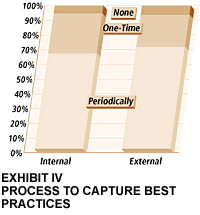 This is a remarkable improvement over where companies were just five years ago, but it begs a question: If so many companies are capturing best practices, why are not the success rates even higher? We will return to that question a bit later.
This is a remarkable improvement over where companies were just five years ago, but it begs a question: If so many companies are capturing best practices, why are not the success rates even higher? We will return to that question a bit later.
The Hewlett-Packard Company is one company that recognized early the importance of best-practice capture to its alliance success. Hewlett-Packard had always recognized that alliances were an important element of its value-creation strategy. Through the late 1980's and early 1990's it formed scores of alliances, and senior management assumed that managers were getting up to speed by attending seminars taught by academics and business schools. At the corporate level, no one was really thinking about technology leakage, exit mechanisms, governance issues, equity commitments or other issues.
This all changed in the early 90's when, to the shock of corporate executives who thought everything was fine, Hewlett-Packard surveyed its managers and found an overwhelming number of them ranked "strategic alliances" as the main area where they wanted more training. The external seminars the managers were attending, they said, were interesting, but they were not Hewlett-Packard specific, and there were no best practices or specifics to follow.
Responding to the survey, Hewlett-Packard took some specific and dramatic steps. (See Exhibit V.) Today, Hewlett-Packard's best-practice development is both internally and externally driven. Internally an in-house best-practice program develops and maintains training sessions, case histories, tool kits and checklists. This material is then reinforced with assessments by alliance partners, comparisons with external best practices of other successful companies and outside case studies. In short, Hewlett-Packard has adopted a disciplined approach to best-practice development that it now sees as a significant advantage it has over other companies.
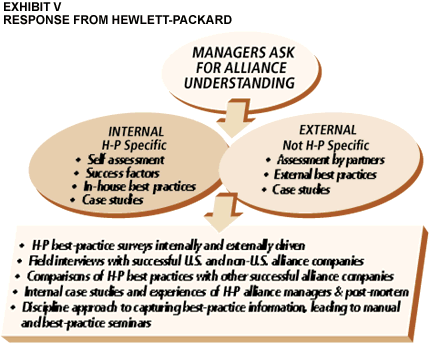
2) Process Discipline. Two-thirds of the executives responding to our survey in 1997 reported that they had an alliance process. Strikingly, though, almost a third of the executives said they did not follow the process. Seems like fodder for the Dilbert comic strip, where too much emphasis is placed on creating processes and not enough on making sure they are used and that they lead to improvements.
At the same time, the survey clearly established that successful companies are more disciplined in following an alliance process than unsuccessful companies. The successful companies do better at integration planning, bargaining power assessment and leverage assessment. (See Exhibit VI.) These are also the areas in which the high-success companies are more likely to incorporate that portion of the alliance methodology in their process than the low-success companies.
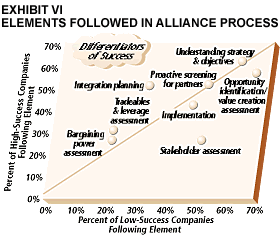
Similarly, almost everyone incorporates some aspect of understanding strategy and objectives, as well as opportunity identification. Only 50 percent, however, incorporate the other individual elements in the process methodology. Generally, we have found, the high number of "yes" answers for opportunity identification and value creation reflect the former rather than the latter. Most companies do a fairly inadequate job at value-creation assessment, and this leads to a lot of failed negotiations.
It is important to note that about half the companies use an alliance database, but few use it to capture lessons learned. Almost all the databases include a description, date formed and a list of all active alliances, but very few get into content in such areas as lessons learned. (Surprisingly, less than 20 percent of the companies using a database include alliance lessons learned.) The successful companies are slightly more likely to use a database, but the more significant difference is in the material in the database. Successful companies are more likely to include lessons learned, key contacts, negotiations under way (to avoid stumbling into each other in potential partners' lobbies) and active and inactive alliances. In short, their databases are much richer in content than the databases the less successful companies use.
Another key element of instilling institutional learning is doing self-assessments and asking one's partners for their opinions, too. About two-thirds of the companies surveyed self-assessments, but less than half ask their partners for assessments. This is a big area of potential improvement for all companies, as the feedback obtained can provide an important source of lessons learned and ideas on how to improve. The feedback can be substantive ("You are not staffing the right people in our venture") or less earth-shattering ("You do not keep us adequately informed" or "You do not respond quickly enough to our phone calls"). Just as when your spouse complains about how annoying it is when you leave the cap off the toothpaste tube, feedback about little matters can help diffuse tensions and avoid patterns of behavior that are disruptive.
As expected, successful companies do more of both kinds of assessments, but the gap in seeking partner assessments is particularly remarkable -- successful companies are twice as likely to do partner assessments as less successful companies. 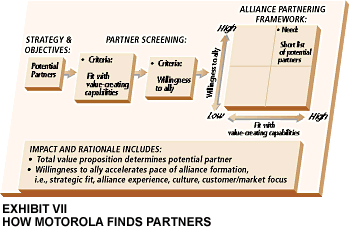
Motorola Inc. recognized early how alliances can play important roles in achieving its goals. After having been through a number of alliances, Motorola's management realized that having a disciplined process was the key to achieving alliance success. One part of the Motorola process involves the selection of strategic partners. (See Exhibit VII.) It starts with a clear alliance strategy and objectives, which are linked to the overall corporate or business strategic objectives. The next steps include partner criteria such as alliance experience and fit with value-creation capabilities, along with the willingness of a potential partner to ally. For first-time partners, Motorola offers an alliance-training seminar to provide information on Motorola's alliance requirements and process.
A best-practice framework for developing a disciplined approach to alliance formation and to building an institutionalized alliance-capability skill base has worked for many companies. One telecommunications company -- this industry is going through rapid, even convulsive, changes -- saw alliances as a way to increase competitive strength and value creation to customers. Our survey of companies found that the "Creative Plan to Bridge Management Styles of Partners," one of the best-practice elements in our framework, was rated as the most important to achieving alliance success. And this telecommunications company set about building this capability in a disciplined way. (The complete set of 100 best practices is a proprietary tool that Booz-Allen & Hamilton uses to help clients focus on what they need to do to improve.)
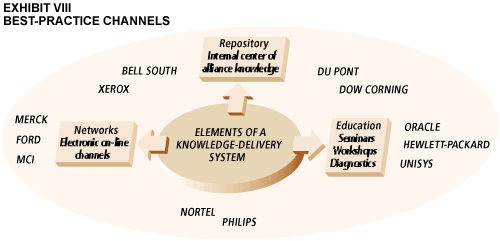
3) Dissemination of Best Practices. The most successful alliance companies have learned that just teaching managers bureaucratic rules does not suffice. Disciplined approaches and channels are needed to disseminate best-practice knowledge and experience. (See Exhibit VIII.) The three most popular are:
a) Electronic networks: One Xerox web site, for example, contains best practices, policies, and lists of alliance experts both internally and externally, and is available to primary employees.
b) Periodic education seminars: Hewlett-Packard, for example, conducts 50 two-day seminars a year as a way of educating its top 1,000 executives.
c) Repositories of alliance knowledge: This is where managers can go to acquire alliance knowledge and assistance. Among the companies creating such repositories are Ford, I.B.M. and the Dun & Bradstreet Corporation.
Note that these approaches are not either/or. Many companies are developing all three capabilities. 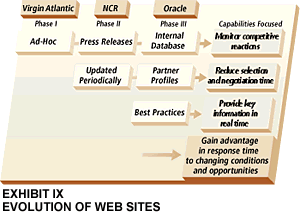
One of the most popular approaches to disseminating alliance knowledge is through a web site. (See Exhibit IX.) Companies usually start in Phase 1, where the system acts in an ad hoc fashion, with only major alliances mentioned and loosely presented. Once alliances are recognized as a major force in an industry, companies move into Phase 2. This is where news announcements are captured, updated periodically and maintained somewhere in the organization.
As more and more alliances enter a company's portfolio, web sites' capabilities expand rapidly, covering such elements as internal alliance and partner databases, partner profiles and news announcements. A company's ability to monitor competitive reaction to its alliances, to reduce partner selection and negotiation time and to provide key information is greatly enhanced by a web site. Successful companies make better use of web sites as alliance repositories: They are twice as likely to have an alliance web site or a repository and the content is dramatically richer. This appears to be one of the biggest differentiators between successful alliance companies.
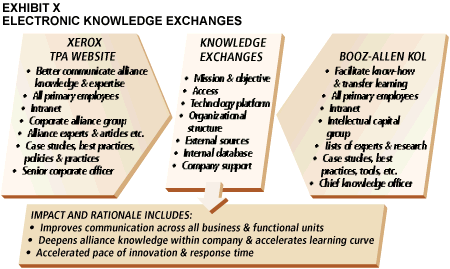
Xerox's web site and Booz-Allen's Knowledge on Line are examples of how companies use web sites to transmit knowledge electronically. (See Exhibit X.) Xerox and Booz-Allen decided some time ago that knowledge available in real time can yield distinct competitive advantages. Xerox positioned its web site in the corporate alliance group; Booz-Allen's Knowledge on Line is managed by Booz-Allen's intellectual capital group and is available across the company. It also contains case studies, best practices, presentations and external and internal intellectual-capital sources.
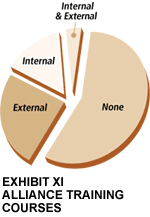
4) Emphasis on Training. Only a third of the companies we surveyed offered alliance training and less than 15 percent had developed their own curriculum. (See Exhibit XI.) Successful alliance companies, however, recognize that alliances are fundamentally different from acquisitions and require special programs to bring managers up to speed.
The BellSouth Corporation recognized the phenomenal growth of alliances in the telecommunications industry. After trying different training approaches, BellSouth decided to put 150 senior managers through an alliance workshop for two days. BellSouth executives learned some intriguing lessons from their experience:
a) People learn from each other.
b) Seminar content must be specific to the company and industry
(as we have also seen at Hewlett-Packard).
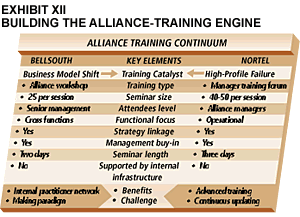 c) Definitions and processes work. Northern Telecom Ltd. also decided, after one alliance failed, that training should become part of its alliance program. It built a program on three legs: organizational planning, three-day workshops and networking. BellSouth and Northern Telecom are also learning by doing -- disregarding what does not work and embracing what does. (See Exhibit XII.)
c) Definitions and processes work. Northern Telecom Ltd. also decided, after one alliance failed, that training should become part of its alliance program. It built a program on three legs: organizational planning, three-day workshops and networking. BellSouth and Northern Telecom are also learning by doing -- disregarding what does not work and embracing what does. (See Exhibit XII.)
5) Organizational Solutions and Embedding. When we asked companies where the alliance functional resources reside, we found that almost every imaginable model seems to exist. About a third of the companies lodged the resources on the corporate level and about a quarter in the operating unit. The balance of companies mixed the resources through the corporate and operating-unit levels. (See Exhibit XIII.)
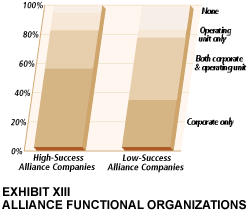 Successful alliance companies were more likely to have corporate functional groups. Almost 60 percent of successful companies have alliance functional groups only at the corporate level, compared with less than 40 percent of the less successful companies. Moreover, 95 percent of the successful companies have some alliance functional expertise somewhere. Finally, less successful companies are twice as likely to duplicate their alliance functional expertise at the corporate and operating units.
Successful alliance companies were more likely to have corporate functional groups. Almost 60 percent of successful companies have alliance functional groups only at the corporate level, compared with less than 40 percent of the less successful companies. Moreover, 95 percent of the successful companies have some alliance functional expertise somewhere. Finally, less successful companies are twice as likely to duplicate their alliance functional expertise at the corporate and operating units.
What this data shows is that by placing alliance-functional capability in both corporate and operating units, the less successful companies dilute their efforts: less learning is captured and transferred. In terms of reporting relationships we also saw that alliance reporting is moving into the executive suite.
Xerox, which has chosen the corporate route, created a corporate group to be relationship managers for key alliances at Fuji Xerox. The job of the relationship manager is to coordinate across the alliance partners. This system offers many advantages and some unique challenges.
Some companies, including Hewlett-Packard, have embedded the alliance function within the business development group. The advantages of this option are that alliances are established within a known and respected area of the company and the staff is kept limited. The disadvantages are a potential conflict in culture with merger and acquisition activities, no clear implementation power and limited linkage to corporate strategy.
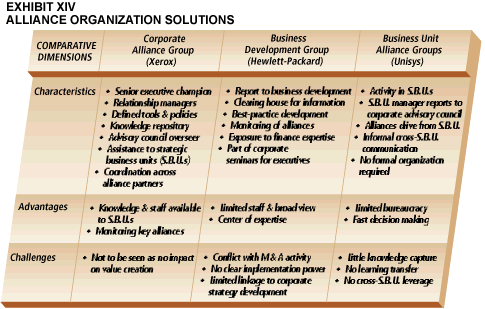
Other companies, including Unisys, have chosen to place alliance activity within each appropriate business unit. Such a structure yields fast decision-making and limited bureaucracy. The potential problems are limited knowledge capture, learning transfer and leverage across strategic business units. (See Exhibit XIV.)
In every case, the right structure is the one that meets your company's needs and objectives. Only value creation is important. Your decision needs to be clearly consistent with your company's culture and mode of decision-making.
IMPLICATIONS FOR MANAGEMENT:
BUILDING CENTERS OF ALLIANCE EXCELLENCE
Global managers must question the adequacy of the way they do business today. A new language of cooperation has emerged. Many companies have already begun to position themselves in this new environment, but they need to "raise the level of their game" in the area of alliance execution by an order of magnitude. Otherwise, they will face a consortium of competitors without the benefit of experience in alliance-building.
The important question is no longer, "Should we form a strategic alliance?" Now the questions are:
1) What types of arrangements are most appropriate?
2) How do we successfully manage these alliances?
3) Are we learning from the experience of ourselves and others?
Judging from the many recently announced partnerships, an increasing number of global enterprises recognize that strategic alliances can provide growth at a fraction of the cost of going it alone. In addition to sharing risks and investment, a well-structured, well-managed approach to alliance formation can support other goals, such as efficiency and productivity. Alliances provide a way for organizations to leverage resources.
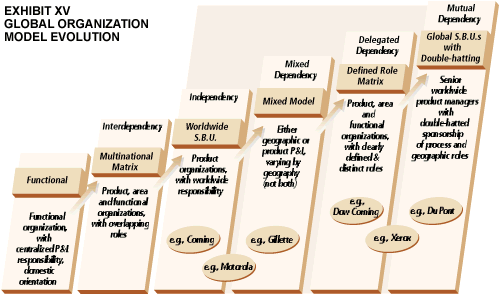
For companies struggling with the appropriate role of alliances in a globalizing industry, we have observed many different organization models. (See Exhibit XV.) In many cases, these organization models are evolutionary, as companies grow from the models on the left to the models on the right. Most organizations start in some form of functional model and move eventually into some sort of matrix organization with overlapping functional, product and area organization. While this kind of interdependence can at least get issues on the table, it tends to fall apart, a victim of its own weight.
The next stage is a corporate strategic business unit model, where the product dimension of the model gains supremacy and reduces overall cost by eliminating the overlaps across geographies. The last three models contain various methods of mutual dependency and interdependency to ensure that the appropriate trade-offs are being made. The mixed-role model has a geographic dimension in charge in some areas of the world and product-line management in others. The Gillette Company is one example of such a company.
The defined role model has different elements of the matrix responsible for different aspects, but it is clear who has control of any single element. The Dow Corning Corporation is an example of this model. Most advanced in evolution is the global strategic business unit (S.B.U.) model, with one executive holding area responsibility and providing functional leadership. E.I. du Pont de Nemours & Company is an example of this. The mutual dependency in this model keeps everyone in a mode of trying to be supportive of and helpful to each other within the leadership team. It also avoids the power struggles inherent in a model where the geographic dimension has a different set of managers than the product-line dimension.
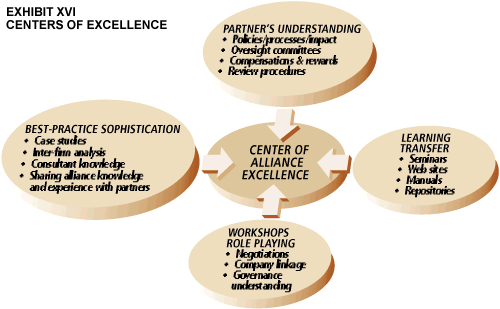
With the new emphasis on capability access, industry lines blur and markets become global. In these newly defined competitive arenas, positional assets are not enough, and new capabilities are required to succeed. The name of the game is to maximize delivered value, to minimize total cost and to gain advantage. (See Exhibit XVI.)
To meet this challenge and take advantage of the many positive elements emanating from alliances, successful alliance companies are moving toward what we call "Centers of Alliance Excellence." Sophisticated alliance companies quickly observe that alliance learning yields big results. To capture this learning and transfer it to key employees, these companies are building best-practice databases augmented by case studies and external expertise, incorporating their partners' assessment into the process, developing learning transfer channels and holding workshops and developing role-playing programs.
As companies depend more on alliances as engines for growth, we expect to see more and more resources devoted to creating centers of excellence. ![]()
Reprint No. 98208
For more information, please see John Harbison's Web site at http://www.smartalliances.com.

